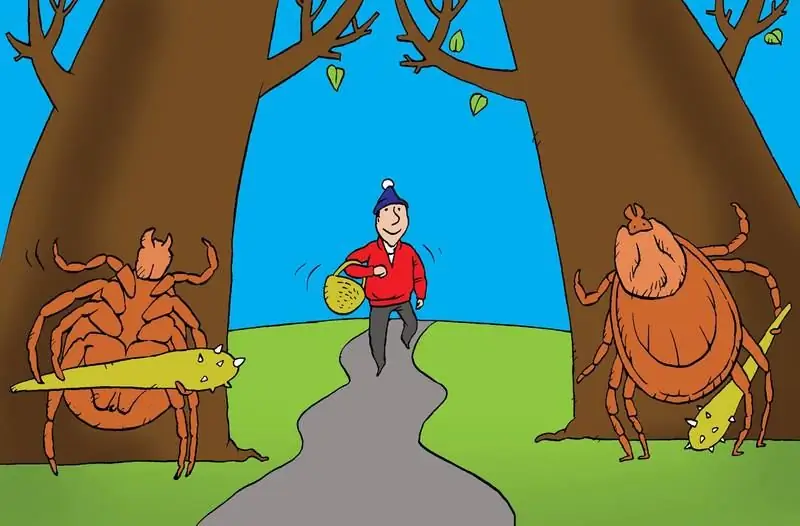
Table of contents:
- Author Bailey Albertson [email protected].
- Public 2024-01-17 22:26.
- Last modified 2025-06-01 07:32.
Bitten by a tick: where to run and what to do

Every year, with the beginning of spring, there are reports of tick attacks on humans in the media every now and then. Sometimes the problem takes on dire consequences. Therefore, you need to know what these arachnids are dangerous, how to recognize their bites and what to do if contact with the parasite has taken place.
Content
-
1 Why ticks are dangerous
1.1 Video: the consequences of a tick bite
-
2 How to understand that a tick has bitten
- 2.1 Photo gallery: what tick bites look like
- 2.2 Video: spots after a tick bite
-
3 What to do if bitten by a tick
-
3.1 How to remove the parasite
- 3.1.1 Video: how to remove a tick using a special twist
- 3.1.2 Video: how to pull out a tick with tweezers
- 3.1.3 Video: how to remove a tick with a thread
- 3.1.4 Ineffective and dangerous methods of removing ticks
- 3.1.5 Video: is it possible to pull out a tick with a syringe
- 3.2 How to treat the bite site
-
3.3 Should I carry the tick to the laboratory
- 3.3.1 Video: where to give a tick for analysis
- 3.3.2 Video: how laboratory tests of ticks are carried out
-
3.4 When to see a doctor
3.4.1 Video: Dr. Komarovsky on tick bites and emergency care
-
Why ticks are dangerous
Feeding exclusively on blood, ticks parasitize humans and mammals. This is unpleasant, but the real threat is different. Ticks are carriers of pathogenic microorganisms, which, getting into the human blood with the saliva of the parasite, can cause a number of serious diseases:
- Tick-borne encephalitis is a very dangerous disease that affects the nervous system, brain and spinal cord, leading to paralysis, up to and including disability. In severe forms, a lethal outcome is possible.
- Borreliosis, or Lyme disease. At an early stage, borrels cause skin irritation, and at a later stage, they destroy joints.
- Anaplasmosis and ehrlichiosis. The bacteria that cause these diseases affect the internal organs: the circulatory, lymphatic and nervous systems.

Small in size (up to 3 mm in length), the tick carries a great threat to human health
Video: the consequences of a tick bite
How to understand that a tick has bitten
Ticks feed slowly and very thoroughly. The female can survive on the host's body for more than a week. All this time, she is constantly developing, not forgetting to periodically inject another dose of anesthetic into the subcutaneous layer so that the victim does not suspect anything and, what good, does not stop the "lunch", because there may not be another opportunity to replenish the vitality. For this reason, a tick bite is most often found along with it.

Mites prefer delicate areas of the skin such as the ear
If a fed tick has already detached, it is not easy to identify traces of its former presence. The bites of all blood-sucking parasites are often accompanied by an allergic reaction, which makes them similar.

Bites of blood-sucking parasites may be similar: on the left - a tick bite, on the right - midges
Nevertheless, it is worth knowing the characteristic signs of a tick bite:
- the tick bites only once, therefore there will be only one bite mark, there can be no other similar ones in the neighborhood;
- the hole itself in the skin is quite large (about 1-2 mm), after the bites of other bloodsucking it is much smaller;
- the spot has a red-pink, sometimes purple hue;
- suppuration of the bite site is possible, as a rule, this is due to the head of the parasite remaining in the skin if improperly removed;
- clearly distinguishable ring-shaped spots that can increase over time are a sign of infection with borreliosis.
Photo gallery: what tick bites look like
-

Tick bite 1 -
When bitten, a tick can sink into the skin to a considerable depth
-

Tick bite 2 - This is what a recently sucked tick looks like.
-

Tick bite 3 - The longer the tick sucks blood, the deeper it sinks into the skin.
-

Tick bite 4 - A blood-drunk tick significantly increases in size and becomes gray in color
-

Tick bite 5 - The fresh bite mark has a bright reddish-pink hue
-

Tick bite 6 - Over time, the bite site tightens and heals
-

Tick bite 7 -
If part of the tick remains under the skin, the wound will fester and heal for a long time.
-

Tick bite 8 - It may look like a bite with an inflammatory process
-

Tick bite 9 - Ring-shaped spots at the site of the bite - a characteristic sign of infection with Lyme disease
-

Tick bite 10 - The tick can dig into the neck
-

Tick bite 11 - Hair is not a hindrance to the tick
-

Tick bite 12 - A tick bite can be accompanied by a severe allergic reaction
Video: spots after a tick bite
What should I do if bitten by a tick
If you find a tick on your body, don't panic. Unfortunately, it is impossible to determine by the appearance of the parasite whether it is infected with a dangerous virus or not. But the statistics data can be somewhat reassuring:
- in areas endemic for tick-borne encephalitis, no more than 40% of ticks are carriers of the virus, that is, less than half of all possible;
- in other, more favorable areas, this figure is much lower and ranges from 2 to 10%.
However, another outcome is also possible, when an infectious agent enters the human blood along with the parasite's saliva, which then causes a serious illness. Therefore, the tick bite should be taken as seriously as possible. And first of all, remove the parasite from the skin. This is the key point. The longer he drinks blood, the more infected saliva enters the body, and the higher the risk of infection.
How to remove the parasite
No matter how terrible the mite is, it is not difficult to remove it from the skin. If you are unsure of your own abilities, you can seek help from the emergency room, provided that it is nearby. Otherwise, it is still better not to waste precious time and get rid of the parasite on your own.
General rules for removing ticks:
- The tick must be removed so that it remains alive. The causative agents of infections are found in his abdomen. And if this belly is crushed, then all of them will enter the bloodstream through the damaged skin, that is, the likelihood of infection will increase dramatically.
- Remove the tick by capturing it as close to the bite site as possible. Pull gently up and to the side in a rotary motion. Don't make any sudden movements. This can cause the mouthpiece to come off.
- If this does happen, remove it with tweezers or a needle, like a common splinter. And if it doesn't work out, just leave it, the skin will get rid of it itself, like a foreign body.
If you are often outdoors, the best option would be to purchase and use special mite extraction tools. They can be called in different ways: pliers, twists and so on. They also differ in design, although they all have a simple one. But they have the same principle of operation:
-
With the help of the device, the tick is picked up as close to the human skin as possible.

Removing a tick with a special device To remove a tick, it is necessary to bring the fork of the device under it and scroll 1-2 turns
- And it is pulled out with a slight rotational movement. At the same time, it is guaranteed to remain alive and unharmed. And the whole process takes a few seconds.
Video: how to remove a tick using a special twist
In a similar way, you can remove the tick with ordinary tweezers with narrow ends.

The tick can be pulled out with tweezers
Video: how to pull out a tick with tweezers
It is possible to remove the tick by hand, but it is not recommended for two reasons:
- there is a possibility that you will not calculate the applied force and crush the parasite;
- viruses and bacteria are found not only inside the tick, but also outside, and through microcracks in the skin of the fingers, they can easily enter the human body.
If you remove the tick with your hands, be sure to use rubber gloves, they will protect against infection. But it is better to use an ordinary thread in the absence of any tools. She, for example, can be pulled out of clothes.

Gloves protect against infection
How to pull out a tick with a thread:
- Make a loop, throw it over the tick and tighten as close to the bite as possible.
- Pull the ends of the thread together and start twisting it in one direction. The thread should be taut and oriented perpendicular to the human body at the site of the bite. But don't be too hard to rip off the parasite's head.
- The tick will be removed very soon.

The tick can be pulled out with a thread
Video: how to remove a tick with a thread
Ineffective and dangerous ways to remove ticks
There is an opinion that the tick must certainly be smeared with some nasty things. Moreover, these nasty things can be very different. In the United States, for example, women prefer to use nail polish or nail polish remover. You can often find recommendations about the use of oil, petroleum jelly, scotch tape, plaster, electrical tape, and the like. With these means, it is necessary to completely block the air supply. It is generally accepted that if the tick has nothing to breathe, then it will retreat, crawl out of the skin and leave, having previously apologized. In reality, things are not going so well. Choking, the tick begins to vigorously let out saliva, which, as we remember, contains dangerous viruses and bacteria. And yet he can die a painful death during this procedure, that is, you still have to extract it in another way.
Another tricky method involves using a syringe. It must be cut off near the injection set hole, and then applied to the skin so that the tick is completely covered. When the plunger is raised, an excess pressure will be created inside the syringe, which supposedly should pull the tick out of the skin. In fact, all these manipulations have no effect on him, but a bruise appears on the skin. The method doesn't work.
Video: is it possible to pull out a tick with a syringe
How to treat the bite site
The skin at the site of the bite must be disinfected:
- Treat with soapy water first. Rinse well and dry.
-
Then lubricate the wound with any antiseptic: iodine, brilliant green, medical alcohol.

Zelenka Zelenka is suitable for disinfection of the tick bite

It is possible to reduce itching after a bite with the help of modern antihistamines.
Do I need to carry the tick to the laboratory
In some areas with high incidence rates, local health authorities recommend testing ticks for dangerous viruses and bacteria. This is not always advisable for a number of reasons:
- In modern realities, laboratories conducting research on ticks do not always have high quality standards used by clinical and diagnostic specialized centers, and may not be certified for a specific type of research. In such cases, there is a high probability of erroneous diagnoses. Positive test results should not be used as a basis for treatment decisions. Negative ones, on the other hand, can lead to false calmness.
- If the analysis is carried out correctly and the tick is infected, this does not mean that you are also infected (we talked about this above).
- You may have been bitten by another tick at the same time that was infected but went unnoticed. The result of the test tick will be negative against the background of developing symptoms of infection.
- Sometimes laboratories conduct research for a long time - the symptoms of the disease appear earlier. If you wait for results, time for treatment will be lost.
Video: where to give a tick for analysis
Most laboratories check for infections in 4 areas at once:
- encephalitis;
- borreliosis;
- anaplasmosis;
- ehrlichiosis.
The service is paid, the cost in Moscow is 1662 rubles. In other regions, the amount may vary slightly. In order for the tick to be suitable for research, it is necessary to deliver it to the laboratory in proper condition:
- Better if he is alive. Place it in an airtight container with a humid environment and take it to the laboratory within 2 days after removal. A resealable bubble is suitable as a sealed package, and a blade of grass or a wet piece of cotton wool inside the container will provide a moist environment.
- Dead ticks are also taken for tests, but add a piece of ice to the container with the tick. This way it will be better preserved.
Video: how are laboratory tests of ticks
When to see a doctor
Tick-borne encephalitis is a really deadly disease. Therefore, immediately after solving all the issues related to the tick, it is necessary to find out from the sanitary-epidemiological service or from the family doctor how things are with this disease in the region. If the risk of infection is high, you can solve all other issues only on the way to the clinic, where the doctor will prescribe the necessary tests and subsequent treatment.
If your region is not endemic for tick-borne encephalitis, you should not relax too much, but the visit to the doctor can be postponed until the characteristic symptoms appear:
- temperature 38-39 ° С;
- severe headaches and eye pains;
- muscle weakness;
- muscle pain;
- nausea.
Do not forget about the second most dangerous disease - borreliosis. It is important here not to miss the beginning of the infection. A timely course of antibiotic treatment will allow you to never remember about Lyme disease. But if, due to carelessness, time is lost, you will get a serious illness for the rest of your life.
A sufficient diagnostic sign of Lyme disease is the presence of erythema migrans (rounded red spots of an annular shape). Size in diameter - 5 cm or more. An increase in the size of the spot may be a manifestation of infection. Skin lesions usually appear on days 7-14. But the range can be 3 to 30 days after the tick has detached or has been removed.
Video: Dr. Komarovsky on tick bites and emergency care
Now you know what to do if you are bitten by a tick. This means you can save your own health and life.
Recommended:
Apricot Red-cheeked: Description And Characteristics Of The Variety, Advantages And Disadvantages, Planting And Care Features + Photos And Reviews

Rules for growing apricot varieties Krasnoshekiy: planting, plant care. Pest and disease control
Pear Chizhovskaya: Description And Characteristics Of The Variety, Advantages And Disadvantages, Planting And Care Features + Photos And Reviews

Features of the Chizhovskaya pear variety. Rules for growing and caring for the crop. Gardeners reviews
Pear Lada: Description And Characteristics Of The Variety, Advantages And Disadvantages, Planting And Care Features + Photos And Reviews

Pear Lada belongs to the early summer varieties. Differs in juicy fruits for universal use. The tree is unpretentious in care, gives stable high yields
What To Do If A Cat Has Bitten Or Scratched, What To Do If The Bite Site Is Swollen (arm, Leg, Etc.), What Is "cat Scratch Disease"

The consequences of cat bites and scratches. First aid to man. Medical assistance: immunization, antibiotic therapy. Preventive actions
A Tick In A Cat Or Cat: How To Remove It Correctly At Home, What Is Dangerous, The Consequences Of A Bite

What a tick looks like on a cat. How to remove it. What to do next. Why is a tick bite dangerous for an animal? How to protect a cat from bloodsuckers. Veterinarian advice
